Birds
Media

Species Types
Scientific Name
Quiscalus quiscula
Description
The common grackle makes “a mistake . . . in trying to sing,” a prominent birder once wrote of its kree-del-eeeeks and chlacks. Yet its iridescent purples, blues, and bronzes please the viewer despite the harshness of the voice.
Media
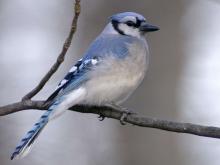
Species Types
Scientific Name
Cyanocitta cristata
Description
Blue jays are notable for their loud voices, blue and white plumage, strong black bill, relatively large size and the distinctive crest atop their heads.
Media

Species Types
Scientific Name
Corvus brachyrhynchos
Description
Crows scarcely need an introduction. A flock of them flapping over a cornfield, against an October sky, is a scene worthy of a painting, but the corn farmer doesn’t see it that way!
Media
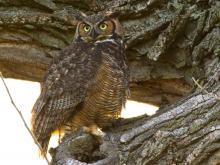
Species Types
Scientific Name
Bubo virginianus
Description
The great horned owl has wide-set ear tufts and a white throat. After dark, you can identify it by its three to eight deep hoots grouped in a pattern, such as “hoo h'HOO, HOO, HOO.”
Media
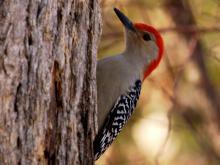
Species Types
Scientific Name
Melanerpes carolinus
Description
A striking woodpecker with grayish white face and underparts, black-and-white banded upperparts, and a red band on the head or nape. The red belly is often not noticeable.
Media
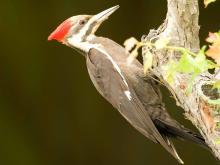
Species Types
Scientific Name
Dryocopus pileatus
Description
The large, crow-sized pileated woodpecker often attracts attention with its loud, resonant drumming high in trees. Confirm your observation by noting its black body with white markings and its red topknot.
Media
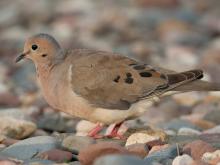
Species Types
Scientific Name
Zenaida macroura
Description
Doves symbolize peace, and they are also a popular quarry of hunters. Our mourning doves are probably the closest living relatives of the extinct passenger pigeon. Learn more about these cooing seed-eaters!
Media

Species Types
Scientific Name
Columba livia
Description
This is the common pigeon of city parks, downtown buildings, barns, and cliffs. Many color forms exist. The wild type has a dark head, breast, and shoulders, a light gray body, two dark bars on the wings, a white rump, and a dark band on the tip of the tail.
Media
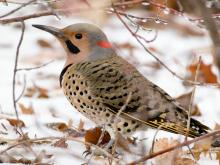
Species Types
Scientific Name
Colaptes auratus
Description
America’s flickers used to be considered three different species, but in the 1980s biologists determined otherwise. Now, our eastern “yellow-shafted” flicker, the “red-shafted” flicker of the west, and the “gilded flicker” of the southwest are all considered just forms of the same species: the northern flicker.
Media

Species Types
Scientific Name
Streptopelia decaocto
Description
The Eurasian collared-dove was introduced in the Bahamas and has rapidly spread throughout most of the United States. At first glance, it looks like a chunky, pale gray mourning dove.
See Also







Media

Species Types
Scientific Name
Hemaris diffinis
Description
The snowberry clearwing is a moth that confuses people because it looks like a bumblebee and flies like a hummingbird!
Media

Species Types
Scientific Name
Hyles lineata
Description
The white-lined sphinx moth sometimes confuses people because it flies, hovers, and eats from flowers like a hummingbird. The adults often fly during daylight hours as well as in the night and are often found at lights.
Media

Species Types
Scientific Name
Darapsa myron
Description
The Virginia creeper sphinx moth is common in woods and brushy areas and comes to lights at night. The larvae eat Virginia creeper and grape leaves.
Media

Species Types
Scientific Name
Perimyotis subflavus (formerly Pipistrellus subflavus)
Description
Tri-colored bats, formerly called eastern pipistrelles, are relatively small and look pale yellowish or pale reddish brown. The main hairs are dark gray at the base, broadly banded with yellowish brown, and tipped with dark brown.
Media

Species Types
Scientific Name
Myotis grisescens
Description
Gray myotises are difficult to distinguish from other mouse-eared bats. A key identifying feature of the gray myotis is that its wing is attached to the ankle and not at the base of the toes. It’s an endangered species.
Media

Species Types
Scientific Name
Myotis lucifugus
Description
The little brown myotis (little brown bat) is one of our most common bats, but populations are declining. White-nose syndrome has taken a heavy toll in northeastern states. This species is now listed as vulnerable across its range.
Media

Species Types
Scientific Name
Myotis sodalis
Description
The Indiana myotis, or Indiana bat, summers along streams and rivers in north Missouri, raising its young under the bark of certain trees. It is an endangered species.
About Birds in Missouri
About 350 species of birds are likely to be seen in Missouri, though nearly 400 have been recorded within our borders. Most people know a bird when they see one — it has feathers, wings, and a bill. Birds are warm-blooded, and most species can fly. Many migrate hundreds or thousands of miles. Birds lay hard-shelled eggs (often in a nest), and the parents care for the young. Many communicate with songs and calls.





















